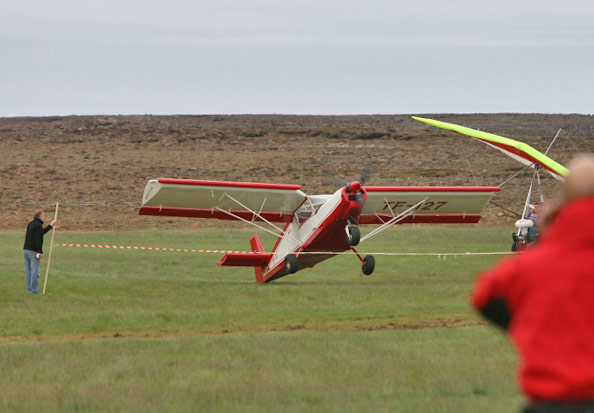denverpilot
Tied Down
It's almost impossible to achieve it even with the CH701:

Dan
That guy bend any metal with that tailstrike?
It's almost impossible to achieve it even with the CH701:

Dan
I always thought a nice slip was kinda graceful. No pun intended
Nope. Not even close. The typical taildragger is about five degrees short of stall angle when in the three-point attitude. Most airfoils will stall at around 17 degrees;
Dan
I have no idea the actual degrees, but with the Tcraft it is very easy to land tailwheel first, and some of my best landings I feel the wheel hit the grass just a moment before the mains.
-VanDy
That guy bend any metal with that tailstrike?
But don't EVER slip a 172 with 40 degrees of flaps.Back when I was flying B727's I've slipped it many times, no big deal.
But don't EVER slip a 172 with 40 degrees of flaps.
I have no idea the actual degrees, but with the Tcraft it is very easy to land tailwheel first, and some of my best landings I feel the wheel hit the grass just a moment before the mains.
-VanDy
BULL. Stall AOA does not change with airspeed. While I suspect it's possible that some bizarre bird sit at a stall attitude, everyone I've ever flown is NOT. It certainly would be difficult to control.A. The design of the three point attitude of a TW aircraft is exactly at the stall AoA at the stall speed.
This is where you make your mistake. Where you no longer have lift to maintain level flight once again *IS NOT* the stall.B. The landing flare in a TW aircraft is set up so that when the wheels touch, there is no more remaining lift(you are stalled)
But the REVERSE IS NOT TRUE. You can be descending while NOT stalled. It's a normal flight regime and includes your alleged full stall landing.C. Unless you have a very powerful engine, and a very light load, you will not be able to maintain 'level flight' once stalled. Also a stall can be entered at many attitudes and speeds but it is not germane to the discussion of this case.
 .
....and speaking of slips. I don't think I knew what a real slip was prior to flying the Super D.
Practicing forward slips in that plane was a blast! I had never seen that amount of rudder authority before.
On my first one, the instructor had to say "stand on the right rudder". I thought I was already standing on it.
Used to have fun with that, teaching 172 pilots to fly Citabrias. The 172 barely even has a rudder.
Dan
That guy bend any metal with that tailstrike?
Used to have fun with that, teaching 172 pilots to fly Citabrias. The 172 barely even has a rudder.
Dan
I'm pretty sure that's a take-off, not a landing.

Then what does a PA28 have?!
Good golly I couldn't get that thing to slip for anything.
Granted I am used to my 182 that decidedly does have a rudder. Likely not the most affective one in the world but it defiantly works
The Cherokees have full time, direct nose wheel steering and I guess that's why they put a big fin on the back of the nose wheel faring, take that wheel pant off and you lose half your rudder authority
something like a decathlon with a symmetrical wing would probably eventually end up in a spin.
Most taildragger pilots think they're stalling above the runway but the truth is many if not most taildraggers require an AoA noticeably higher than what the 3 point attitude provides in ground effect. In reality you simply reach the point where the airflow over the wing is insufficient to create enough lift to support the airplane and it settles to the runway. You can see at this altitude if you perform a stall from level flight while looking out the side to see your pitch attitude. I think you'll discover that the pitch attitude is considerably higher then than what you have sitting on the ground.My landings in a tailwheel plane generally include a full stall about 1/32" above the runway. Well, at least that's my goal.
And welcome to the OP. You'll get plenty of fact-based advice here. Some of it might even be right.
+5 knots from stalling - add into that mix the reduction of drag from being in ground effect - and you are prob a good 10-15 knots from stalling at that point in a light twin or single.
You are not 'broadside' to the 'air flow' at any time - yes, you are flying at an angle to relative wind, but its not 'broadside.'
